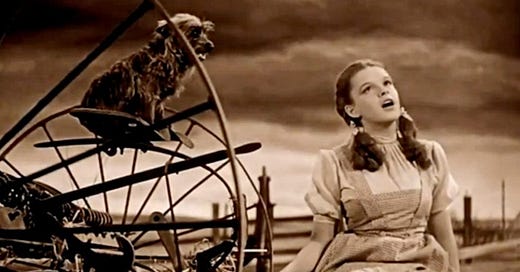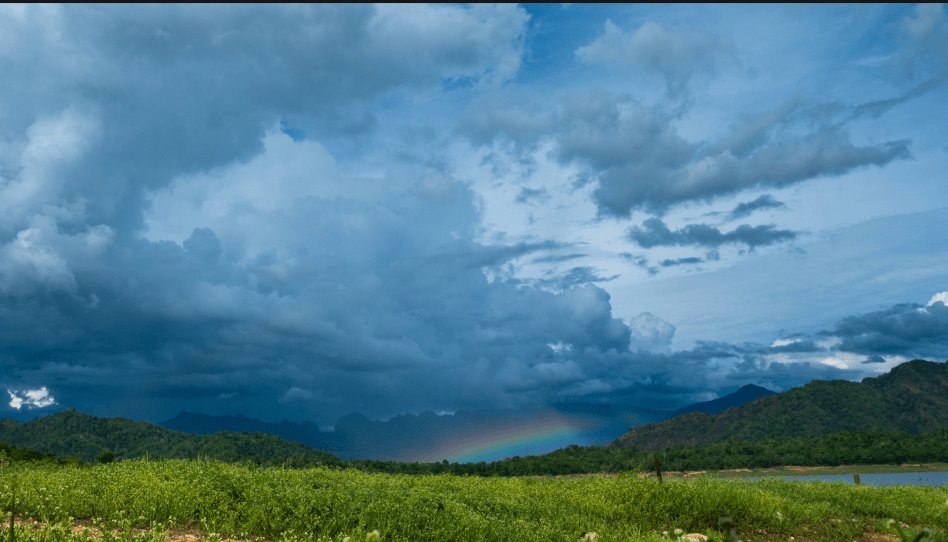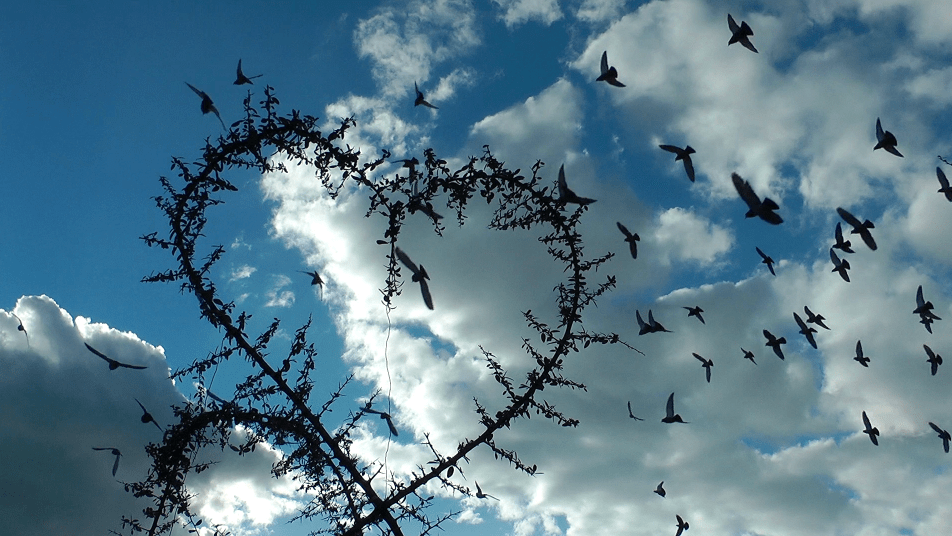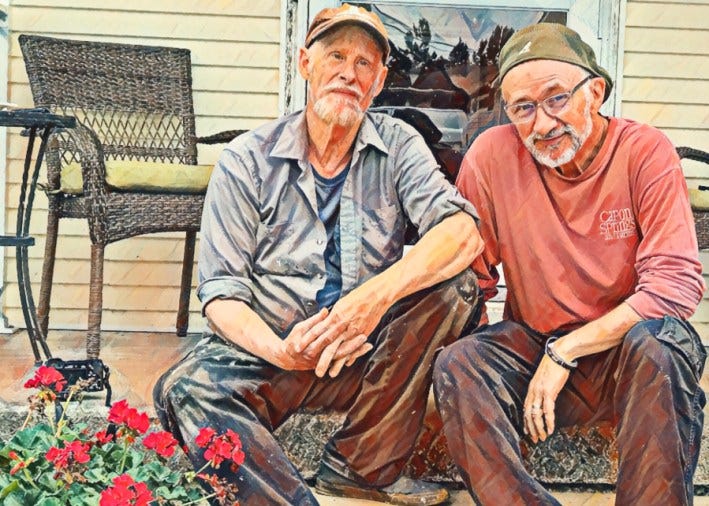Away Above the Chimney Tops
An “Over the Rainbow” Primer & Duet on a song that almost didn't make the cut | May 24, 2023

EDITOR’S NOTE: I originally published this post in 2020, but am re-upping it today, after having sung “Over the Rainbow” in a group setting in Philadelphia recently, mentioning the song’s backstory and wishing to pass that history — and the duet below — forward to new friends.
By Douglas John Imbrogno | TheStoryIsTheThing.com | may24.2023
When I weary of wannabe American autocrats, I may devote the better part of a day to knitting pixels into a video, to accentuate something a tad more positive. One such video (below) presents a sweet 2019 rehearsal duet of “Over the Rainbow,” with my musical partner of many years, Albert Frank Perrone, and me on matching vocals and a Guild classical guitar. While looking up another song of mine, I came upon our harmonic convergence from this rehearsal recording and wove a quickie music video around it.
We don’t sing as much as we used to together, since Albert moved in 2020 from the capital city of West Virginia into the state’s outback, within hailing distance of the Green Bank Observatory. He and his wife sought elbow room and more rural and healthy environs. (My theory is Albert also hopes to be more easily located by his people when they return from his home galaxy, helped by having a world-class radio telescope in his new neighborhood. )
CLICK TO VIEW MUSIC VIDEO
“Let the boys have the damn song.” ~ MGM chief Louis B. Mayer
The original song showcases music by Harold Arlen and lyrics by Yip Harburg. It was crafted in 1939 for “The Wizard of Oz,” and, of course, made legendary by a young Judy Garland. Little-known fact: the song almost didn’t make the cut for “The Wizard of Oz.” An advance screening ditched the tune, after it was removed by MGM executives who felt it slowed down the movie. In one of the 20th century’s most notable creative hissy fits, associate producer Arthur Freed issued an ultimatum, telling MGM head honcho Louis B. Mayer:
“The song stays — or I go.”
“Let the boys have the damn song,” Mayer reportedly responded. “Put it back in the picture. It can’t hurt.”
The rest is movie and popular culture history. In 2001, “Over the Rainbow” was voted the greatest song of the 20th century in a joint survey by the National Endowment for the Arts and the Recording Industry Association of America.
“The song’s mix of hope and anxiety has allowed people to read into it their own concerns.”
The song became such a legend that an entire book was written about it, “Arlen and Harburg’s Over the Rainbow,” by music professor Walter Frisch. “It might not seem obvious that a song performed by a young girl at the beginning of a fantasy movie would take on a life of its own,” Frisch said in a 2017 profile in the Columbia News. Yet the song speaks to the universal appeal of a child’s desire to get away or escape, he said.
Or many of us adults, for that matter.
“The song’s mix of hope and anxiety has allowed people to read into it their own concerns,” Frisch observed.
After all, he added, without the context in the “Oz” story would you have any clue the singer stood beside a tractor on a windswept Kansas farm with an audience of one yippy dog?
Harold Arlen was one of the 20th century’s greatest songwriters. (“Stormy Weather” is another of his tunes, written along with Ted Koehler, known the world over.) A trademark move of Arlen’s songwriting is heard at the outset of “Over the Rainbow,” notes the article. Arlen liked to begin a song with “an octave leap,” Frisch explains, as in the song’s opening syllables: “Some-WHERE …”
The article goes on to note that the line “Someday I’ll wish upon a star …” was intended to mimic a child’s piano lesson exercises. That was Arlen’s claim. Harburg had a different recollection — it was the way Arlen whistled to call his dog, he said.
As for the plaintive, eternal question that concludes “Over the Rainbow” — a question, it should be noted, that never gets answered — the line came from that oldest of artistic obstacles: writer’s block. (Or maybe songwriter’s block.) As Frisch writes:
When Harburg and Arlen were stuck on an ending for the song, Ira Gershwin stepped in to help. When asked why he suggested ending the song with the question, “Why, oh, why can’t I …” Gershwin later recalled, “Well, it was getting to be a long evening.”
“… Everyone knew that she was going to sing it, but the audience would have to clamor for it.”
The song became a “sacred” standard and veritable anthem for Garland throughout her career, if not an albatross, at times. She once described how it felt to be obliged to sing a song later in life she had made famous as a girl: “It’s like being a grandmother in pigtails.” Saddled with the lifelong obligation to sing “Over the Rainbow” at some point during her concert sets, Frisch notes, Garland made the best of it, playing with the tune and changing its “tempo, timbre, rhythm, phrasing, diction and choice of pitches.”
The song came to be the final song of the evening at her concerts. But audiences had to work for it, writes Frisch. “At her Carnegie Hall concert in 1961, everyone knew that she was going to sing it, but the audience would have to clamor for it.”
As for this humble version by Albert and myself, please note it was recorded to an iPhone. In the second floor of a house. Across from a power station in West Virginia’s capital city. So, like, don’t expect recording polish. But it does have, I feel, some harmonic soul—which should go with the territory of one of the most soulful tunes in the American songbook.
Albert first debuted the angelic harmony you’ll hear when we sang “Over the Rainbow” at a memorial for disability rights activist David Stewart some years back, in the capacious, echoing interior of the West Virginia State Capitol rotunda. I dream of doing a full-bore professional recording of the song in the Rotunda with him someday.
If he doesn’t depart for his home galaxy, first, that is.
FREE SUBSCRIBE
For updates on new essays, poems, diatribes, photo essays, experimental videos & sorta memoir excerpts, subscribe to this site’s free e-mail newsletter: TheStoryIsTheThing.substack.com








